Sri Lanka’s history can be traced back to prehistoric times. Most of the early kingdoms were centered in the central north of the country. Today all that’s left are the vestiges of their sacred monuments.
The city of Anuradhapura was the capital city of the Sinhalese Empire for over 1000 years beginning in the 3rd century BC. There are many ruins from these times, but as they are so old, they are not in very good condition. Much of what remains are Buddhist dagobas (stupas) and the ruins of monastery buildings. There are so many ancient Buddhist sites around Anuradhapura that it is dubbed the ‘Sacred City’. The ruins are spread over a few kilometers, so we rented run-down bicycles for the day. This would have been great, except that, the chain on Richard’s bike fell off at least 100 times! We were already sightseeing and biking in 35° C heat, we didn’t need that extra frustration.
Thuparama Dagoba, built in the 3rd century BC, is the oldest stupa in Sri Lanka. It may even be the oldest stupa in the world. Buddhists believe it contains the right collarbone of Buddha, making it a very important site. There are unusual tall, stone pillars surrounding the dagoba that may have part of a vatadage; a circular wall around a stupa for protection. We saw other other dagobas in the sacred city area with similar pillars and an intact one a week earlier in Polonnaruwa’s Quadrangle.

Rice fields with a dagoba in the background, Anuradhapura 
Thuparama Dagoba, Anuradhapura 
Thuparama Dagoba, Anuradhapura
The shape of dagobas in Sri Lanka is unique with a large hemispherical dome base and a tall spire on top. The two brick dagobas, Abhayagiri and Jetavanarama, were built 400 years apart (1st BC and 3rd AD) but look remarkable similar. Both are massive today at 75m tall, but at one time were over 100m high. Abhayagiri Dagoba has dozens of stone elephant carvings around its base which is different from anything we’ve ever seen before. It’s an interesting design element and shows the significance of the elephant to prehistoric kings. At the four cardinal points of Jetavanarama Dagoba are tall stone ornamental façades, called vahalkadas, with many stone carvings of elephants, dwarfs, dancing women and mystical creatures. During the 3rd century AD, this dagoba was 122m high making it the 3rd tallest structure in world behind two Egyptian pyramids.
Ruvanelraya Dagoba from the 1st century BC is another massive stupa at 55m tall. This white stupa is surrounded by an interesting white wall with large grey elephant sculptures. This is also something we’ve never seen before. From pictures of all three of these dagobas you can see their size by comparing the height of the people walking in front.

Abhayagiri Dagoba, Anuradhapura 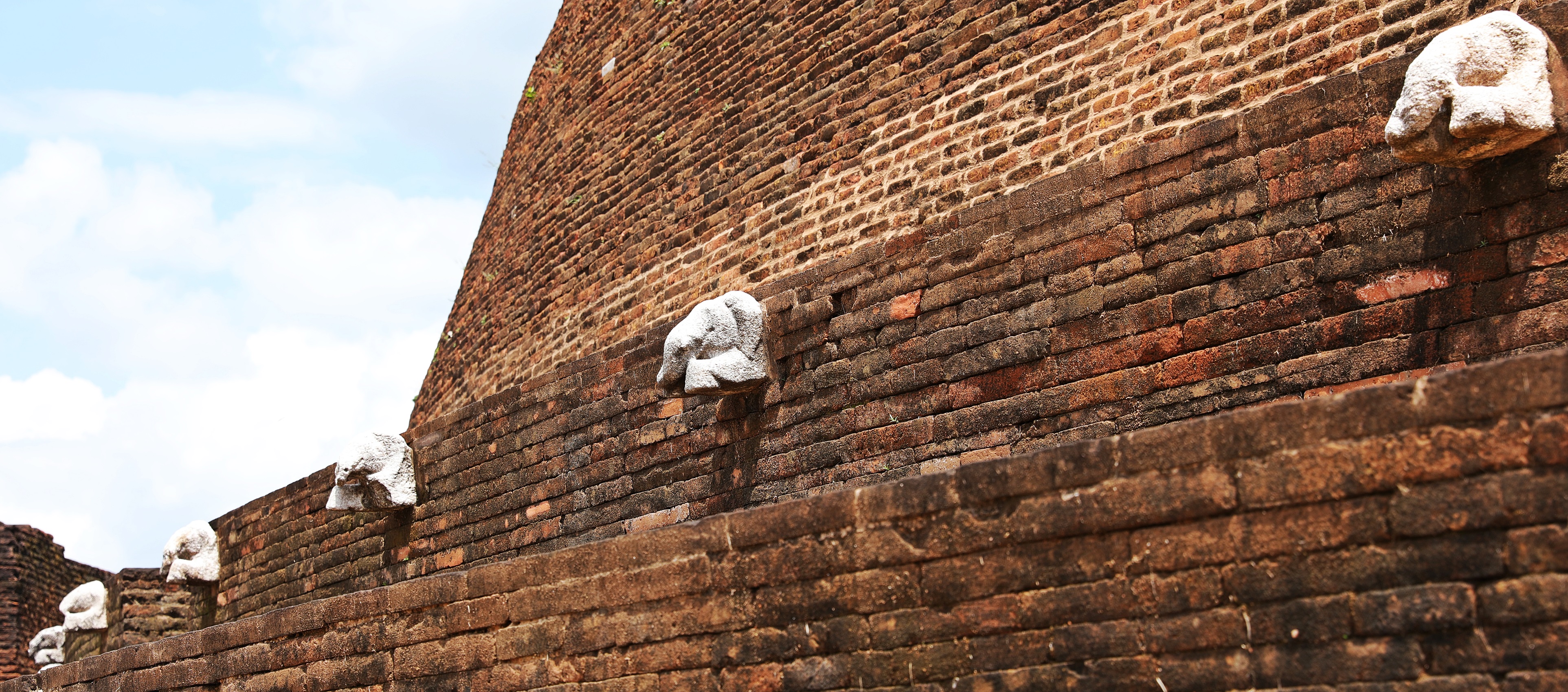
Elephants on Abhayagiri Dagoba , Anuradhapura 
Jetavanarama Dagoba, Anuradhapura 
Jetavanarama Dagoba, Anuradhapura 
Carvings, Jetavanarama Dagoba, Anuradhapura 
Ruvanelraya Dagoba, Anuradhapura 
Ruvanelraya Dagoba, Anuradhapura 
Elephant wall, Ruvanelraya Dagoba. Anuradhapura 
Ruvanelraya Dagoba. Anuradhapura 
Ruvanelraya Dagoba. Anuradhapura
Between these main dagobas are the ruins of hundreds of other dagobas and monastery buildings that are now only a few brick layers high. Many were cells for monks to live. There were at least two monasteries that had well over 10,000 resident monks and many smaller monasteries in the area. In one monastery are the fascinating Twin Ponds. The ponds are most likely from the 1st century BC and were built using technology that is considered very advanced for primitive man. Water runs from 3 different reservoirs through underground pipes and four filters before reaching the ponds. The water flows into the northern pond through a spout that is carved with images of mystical creatures. An underground pipe takes water from this pond to the southern pond. It is a remarkable structure for prehistoric times.
Across from the Twin Ponds is a sculpture of Buddha from the 3rd or 4th century. Samdhi Buddha is considered the best Buddha statue in Sri Lanka. To the uneducated eye though, it appears the same as others we’ve seen.

Rice fields with a dagoba in the background, Anuradhapura 
Lankarama Dagoba, Anuradhapura 
Southern pond, Anuradhapura 
Spout on northern pond, Anuradhapura 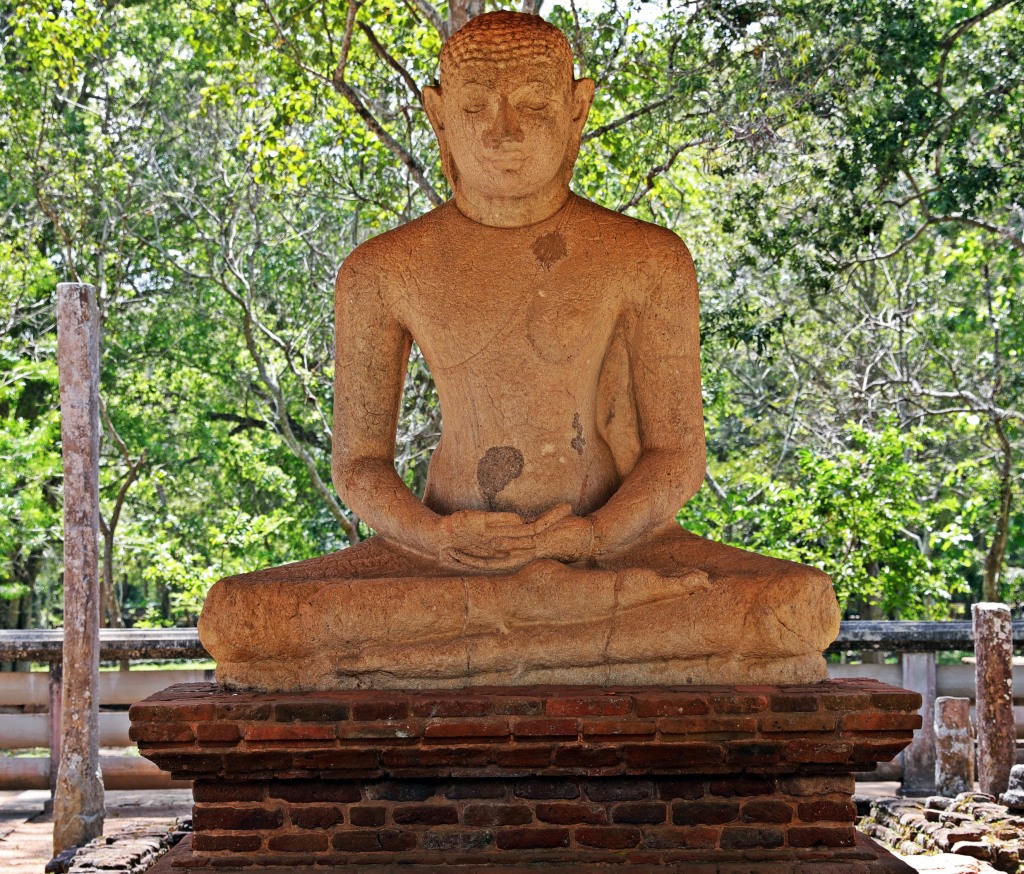
Samadhi Buddha, Anuradhapura
Closer to town is Sri Maha Bodhi Temple which is built around an ancient Bodhi tree. The tree was apparently grown from a slit of the original Bodhi tree under which Buddha attained enlightenment in Bodhgaya, India. That would make this tree over 2000 years old! It is, therefore, a very important Buddhist site but the temple was rather plain considering its significance. There was puja when we were there. During the ceremony, musicians led a group of devotees who carried an elaborate canopy with offerings to the bodhi temple. It was more simple than pujas in other Buddhist countries.
Just beyond the temple are the ruins of Brazen Palace. All that remains are 1600 columns from the palace structure. There were many grey langurs in the forest around the Sri Maha Bodhi temple. They’re not usually aggressive monkeys, but we surprised one who was digging in a garbage can. He reacted by growling at us and showing his teeth which are in desperate need for dental care.


Sri Maha Bodhi Temple, Anuradhapura 
Puja at Sri Maha Bodhi Temple, Anuradhapura 
Puja at Sri Maha Bodhi Temple, Anuradhapura 
Worshipers at Sri Maha Bodhi Temple, Anuradhapura 
Grey Langur with bad teeth, Anuradhapura 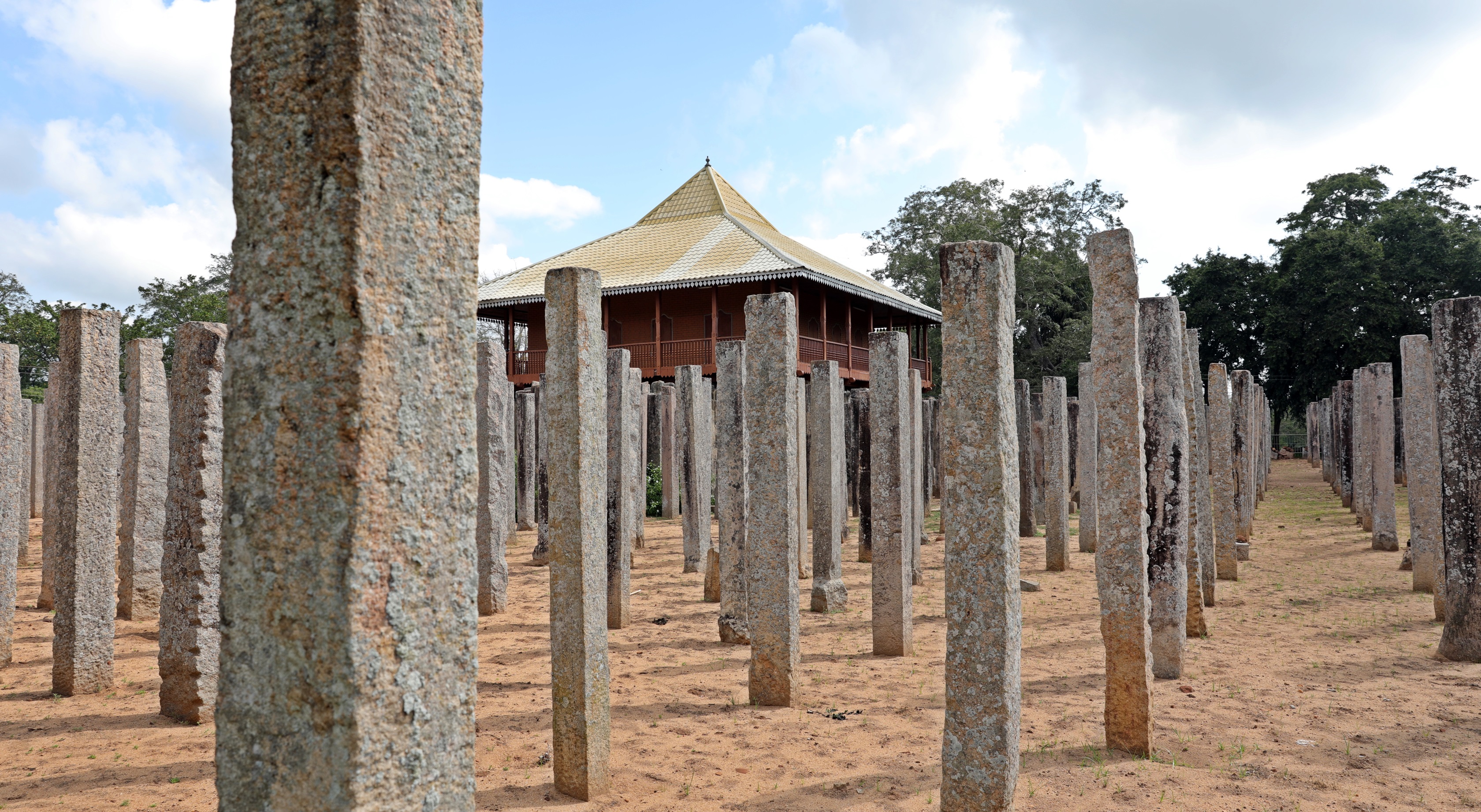
Brazen Palace, Anuradhapura
The final site in Anuradhapura is quite different from the others we visited. Isurumuniya Vihara is a cave temple from 240 BC. The cave is in front of a green lotus pond. Near the entrance to the cave are two large carvings. One carving is an elephant and the other is a man seated in a royal pose. Archaeologists found many other interesting carvings in this area that are on display in a museum on site.

Elephant carving, Isurumuniya Vihara 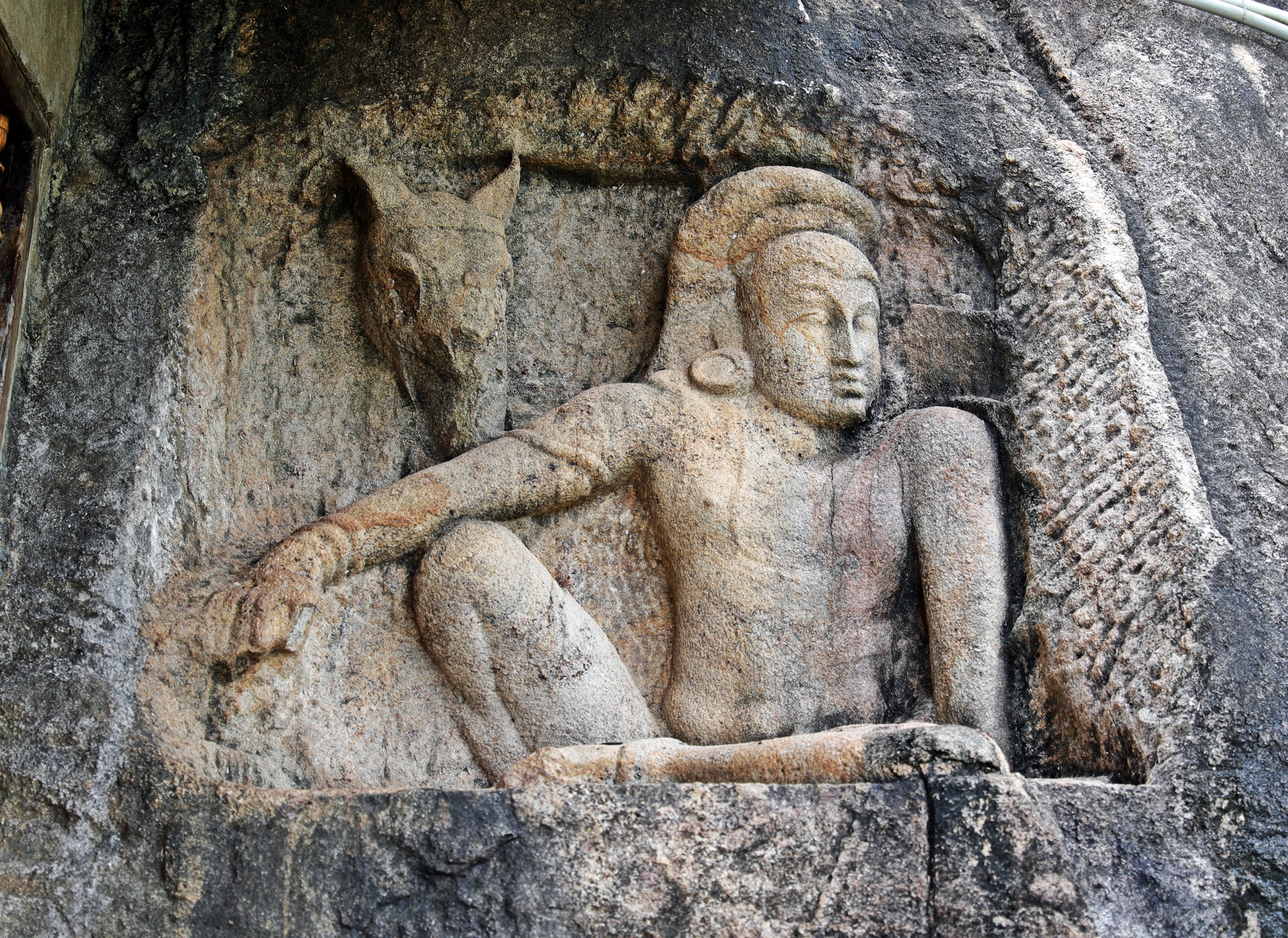
Man in royal pose, Isurumuniya Vihara
The Sacred City of Mihintale is a small village with a very important past. In the 3rd century BC, King Tissa was hunting on a hilltop in the forest near Mihintale when he met an important Buddhist monk from India. The monk spoke with the king for a while and in the end, the king converted to Buddhism. This is, therefore, considered the birthplace of Buddhism in Sri Lanka. Part way up the forested hill are ruins from a 1st century AD monastery. The monastery’s Relic House has two large stone tablets with engraved writings. The tablets list the duties of the monks such as; brush your teeth, meditate, recite your chants and then have breakfast. Another tablet lists the various duties of the staff and how much each would be paid.
Next door, the Alms Hall has a large stone trough for cooking rice called a rice boat and another boat for porridge. Nearby is a stone water tank with high walls. On the side is the remains of a large lion sculpture considered the best sculpture for its time. When the tank is full of water you could drink from a stream of water coming out from the lion’s mouth.
The monastery ruins are surrounded by large trees. In one tree we saw a few Giant Grizzled squirrels and a Toque macaque.

Relic House with stone tablets, Mihintale 
Stupa ruin in monastery, Mihintale 
Rice boat in monastery refractory, Mihintale 
Can you spot the lion on the water tank? 
Grizzled giant squirrel, Mihintale 
Toque Macaque, Mihintale
From the monastery, there is a steep stone staircase that leads to Ambasthale Dagoba. This dagoba marks the important meeting point between the king and the Indian monk. There’s a statue of King Tissa looking toward the stupa. We saw a puja at this dagoba, which was similar, but even less elaborate than the one we saw at Sri Maha Bodhi Temple. On top of another peak is Mahaseya Dagoba which contains the ashes of the Buddhist monk. There was a cute Toque Macaque eating the lotus flower offerings that were left on an alter beside the dagoba. Across the hilltop is a lookout called Aradhana Gala that was used by the monks for meditation.
On a separate hillock is the 2nd century BC dagoba, Kantaka Chetiya, with exquisite friezes of elephants and crocodiles. During this time, the surrounding hillside had at least 68 cave temples that were used by the monks. At the base of the hill are more monastery ruins including Indikatu Seyaa, a stupa on an unusual square base, and a monastic hospital.

Stone staircase, Mihintale 
Ambasthale Dagoba, Mihintale 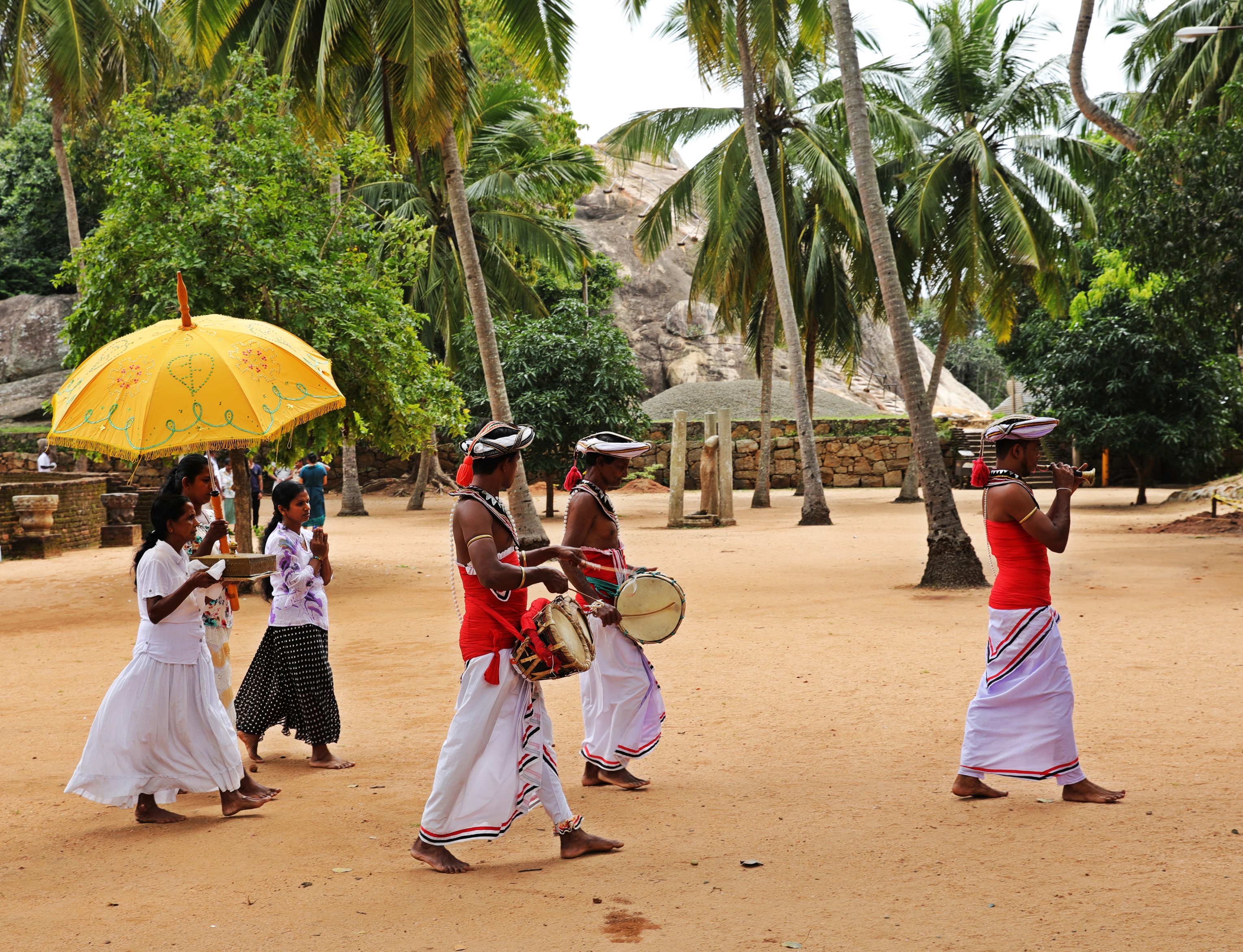
Puja, Ambasthale Dagoba, Mihintale 
King Tissa, Mihintale 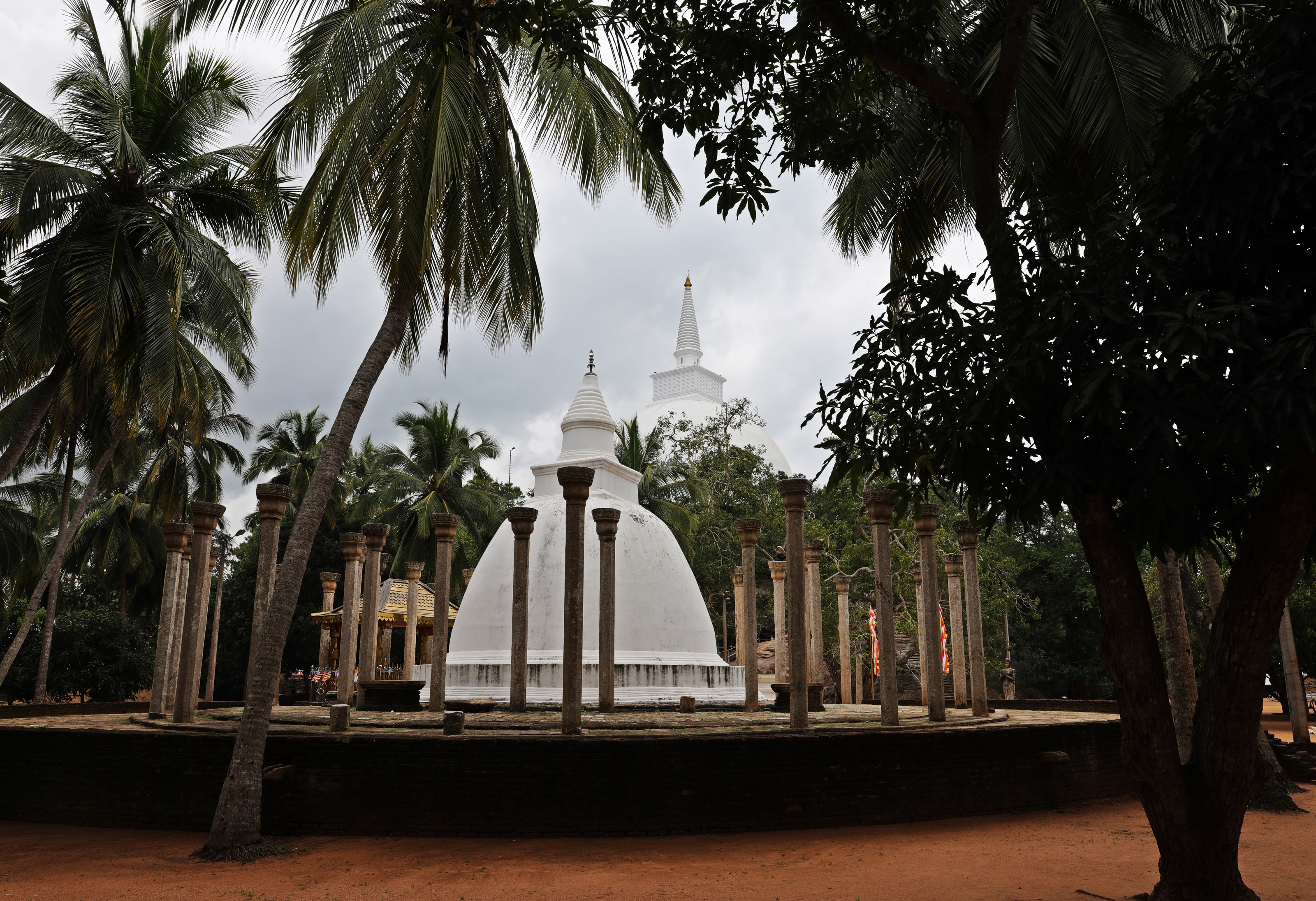
Ambasthale and Mahaseya Dagobas, Mihintale 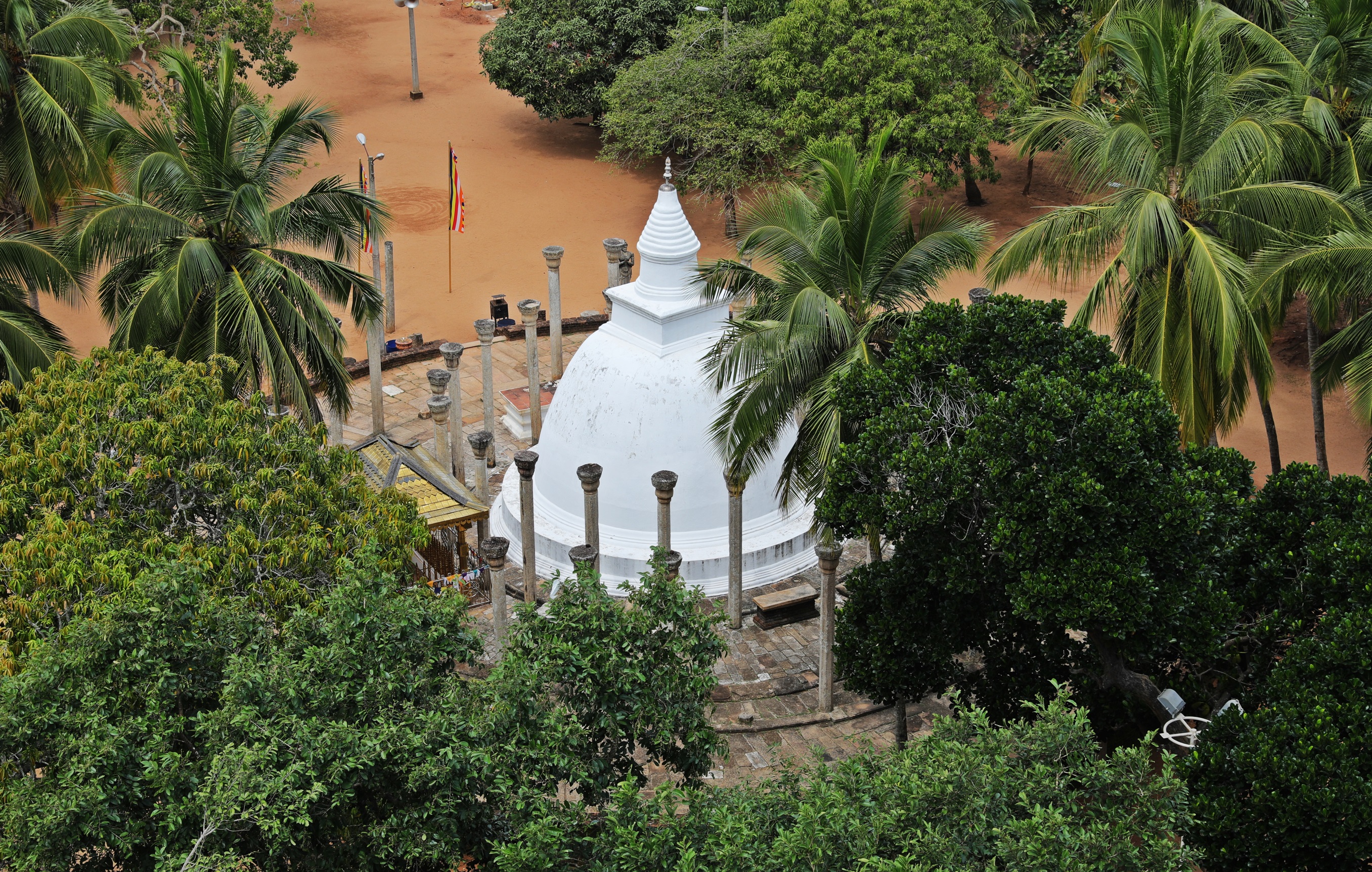
Ambasthale Dagoba, Mihintale 
View of ruins in Mihintale 
Toque macaque eating offerings at Mahaseya Dagoba, Mihintale 
Aradhana Gala lookout, Mihintale 
Kantaka Chetiya, Mihintale 
Indikatu Seya, Mihintale 
Monastic hospital ruins in Mihintale, Sri Lanka
Seventy km south of Anuradhapura is another rock fortress from the 13th century. Yapahuwa Fortress had a short-lived history as it was only used for 8 years. At the base of the rock is an old cave temple with brightly painted frescoes on the walls and a low ceiling. The main structure that remains from the fort is one section of an elaborately carved stone staircase. It is decorated with sculptures of elephants, lions and dancers. A sketch of one of the lions is on the 10 Rupee note. The staircase is very steep with very small steps, so you had to pay more attention in the sweltering heat. At the top of the staircase there used to be a temple that housed the Sacred Tooth Relic for 11 years. Now there are only a few bricks remaining. We hiked to the top of the hill where there are a few remains of the fortress and a nice view of the countryside.

Yapahuwa Rock 
Cave temple, Yapahuwa 
Cave temple, Yapahuwa 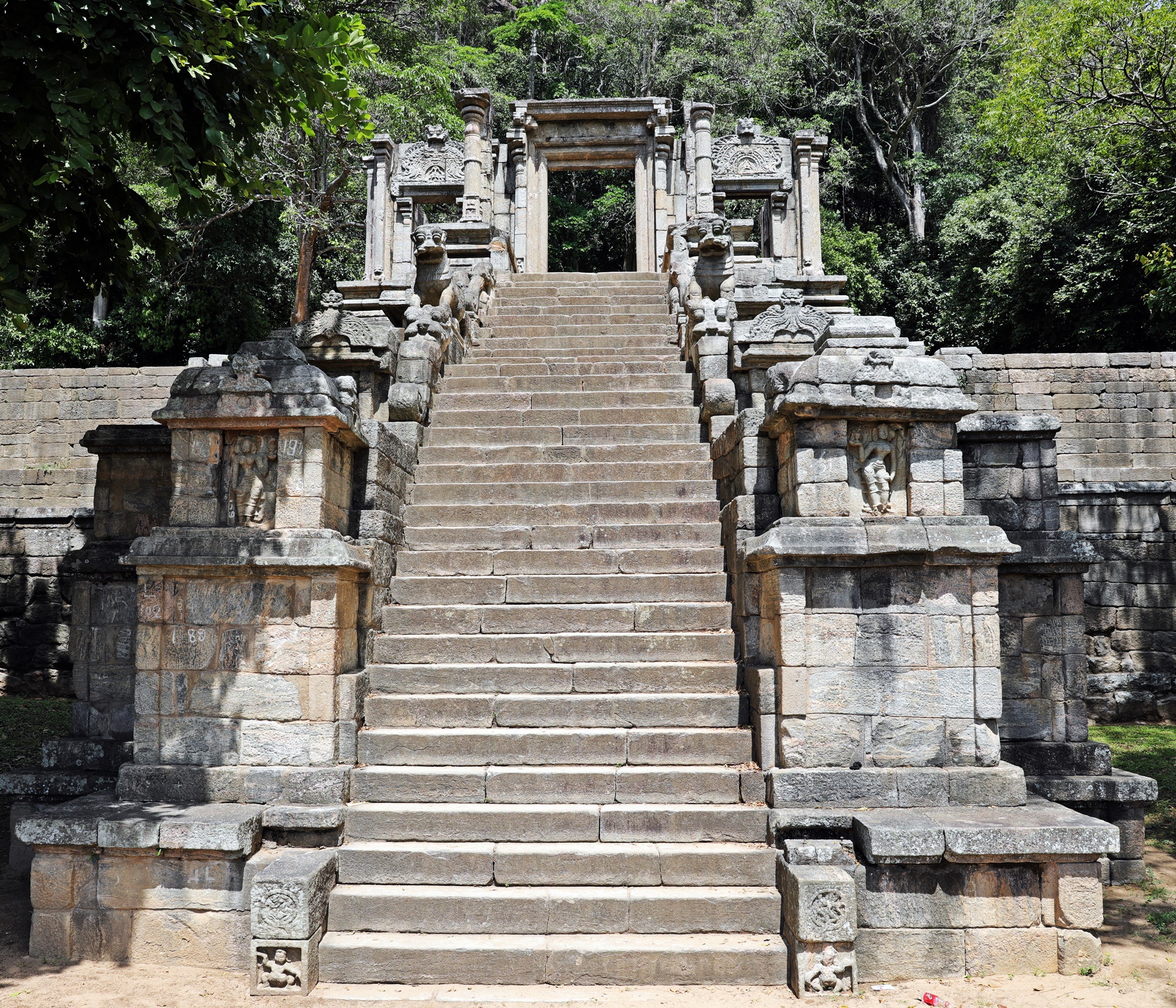
Elaborate staircase, Yapahuwa 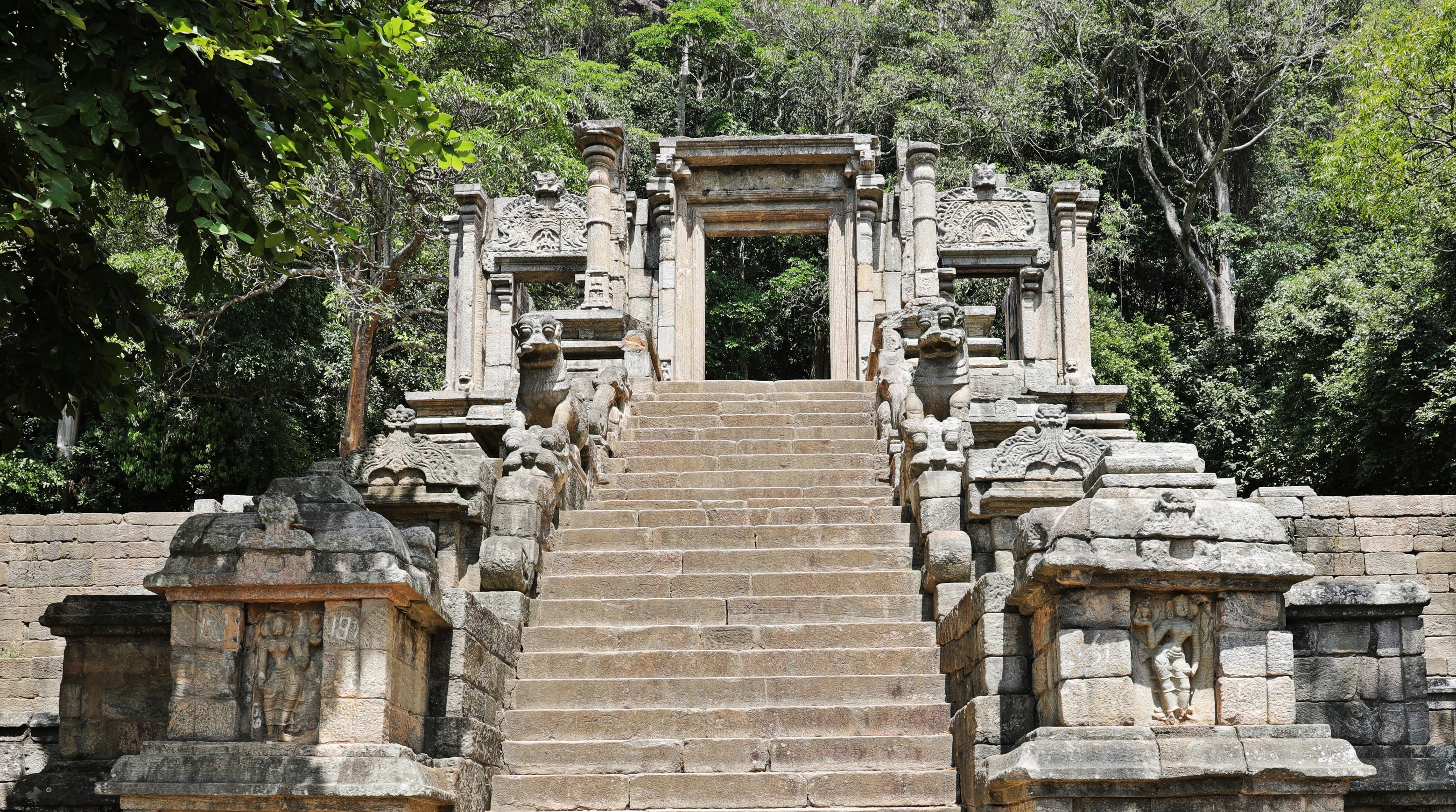
Elaborate staircase, Yapahuwa 
Lion Sculpture, Yapahuwa 
Elaborate staircase, Yapahuwa 
View from, Yapahuwa 
Dagoba ruins, Yapahuwa 
View from Yapahuwa 
Dagoba ruins, Yapahuwa
Coming up next: Kite Surfing on Sri Lanka’s Western Beaches
For extra pics from this trip go to Gallery/Sri Lanka.
For extra pictures from other blogs go to Gallery at monkeystale.ca
To read about more of our adventures go to Destinations.
If you like what you read, please comment or share it using the links below.
Once again, some great pictures there. The Elephant Wall, Stone Staircase and the Puja activities are captivating.
LikeLiked by 1 person
Thank you, it was very different from what we’ve seen elsewhere. They were impressive to see such old architecture.
LikeLiked by 1 person
Thank you for stopping by my address.
LikeLiked by 1 person
I admire how you visit and report about these places with such thoroughness. The giant dagobas are really impressive especially when you see their size in comparison to the people walking around them. Your puja shots are wonderful as are your monkey photos (the bad teeth guy and offerings-eater crack me up) and that squirrel shot is awesome.
LikeLiked by 1 person
Thank you so much Caroline. I think the size of the dagobas is the most impressive and interesting part for being so old.
LikeLike
I love your pictures!!!!! And your experience report!! Thank you for sharing!
LikeLike
your photos are superlatively beautiful, your descriptions accurate, the humor that makes people smile pleasantly sometimes does not lack.
thank you!
LikeLiked by 1 person
Thank you so much! Sri Lanka is a wonderful country to photograph.
LikeLike